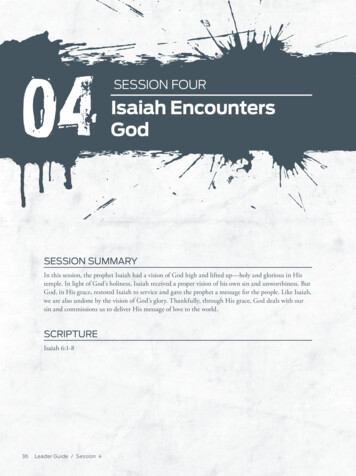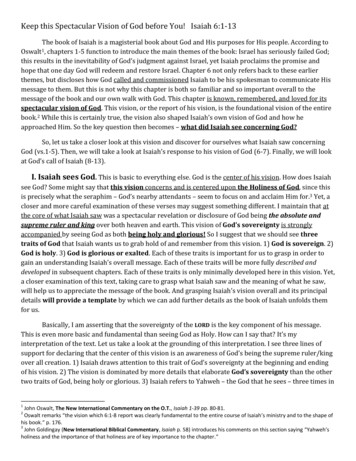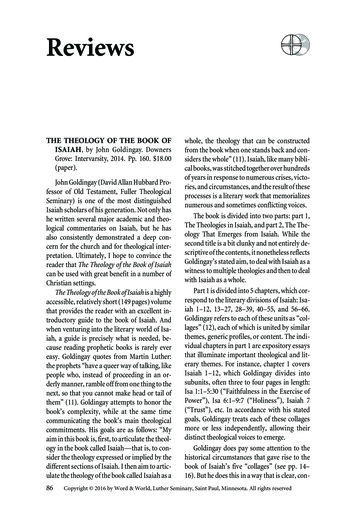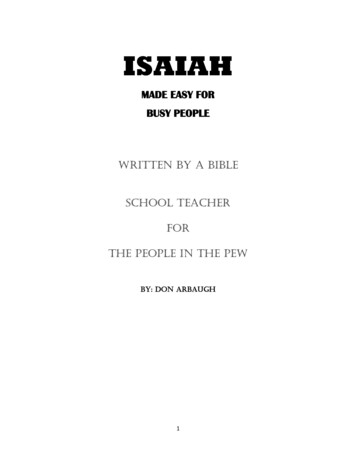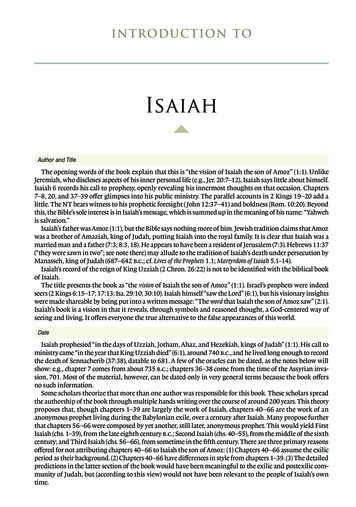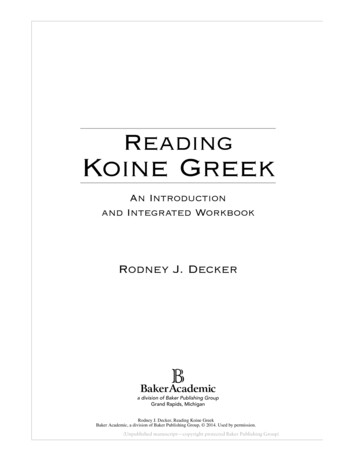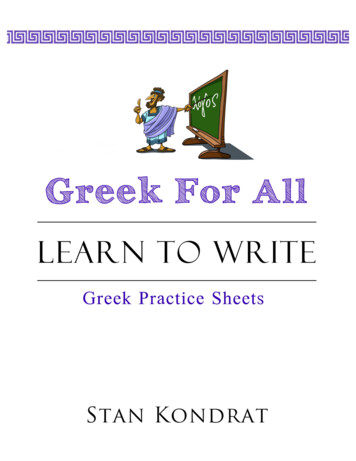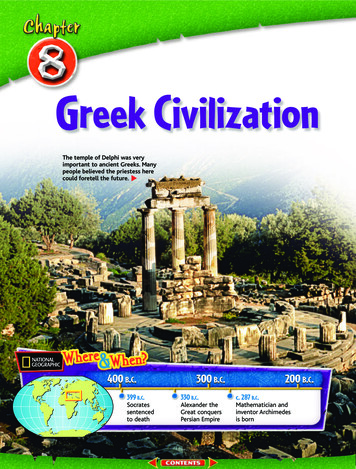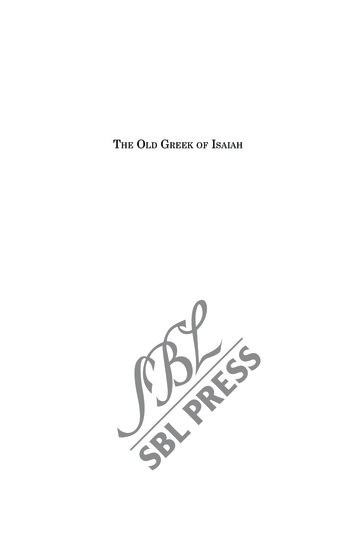
Transcription
The Old Greek of Isaiah
Septuagint and Cognate StudiesEditorWolfgang KrausEditorial BoardRobert HiebertKaren H. JobesSiegfried KreuzerArie van der KooijVolume 61The Old Greek of Isaiah
The Old Greek of IsaiahAn Analysis of Its Pluses and MinusesMirjam van der Vorm-CroughsSBL PressAtlanta
Copyright 2014 by SBL PressAll rights reserved. No part of this work may be reproduced or transmitted inany form or by any means, electronic or mechanical, including photocopying andrecording, or by means of any information storage or retrieval system, exceptas may be expressly permitted by the 1976 Copyright Act or in writing fromthe publisher. Requests for permission should be addressed in writing to theRights and Permissions Office, SBL Press, 825 Houston Mill Road, Atlanta,GA 30329, USA.Library of Congress Cataloging-in-Publication DataVan der Vorm-Croughs, Mirjam.The old Greek of Isaiah : an analysis of its pluses and minuses / Mirjam vander Vorm-Croughs.pages cm. — (Society of Biblical Literature Septuagint and cognate studies ; no. 61)Includes bibliographical references and index.ISBN 978-1-58983-978-6 (paper binding : alk. paper) — ISBN 978-1-58983980-9 (electronic format) — ISBN 978-1-58983-979-3 (hardcover binding : alk.paper)1. Bible. Isaiah. Greek—Versions—Septuagint. 2. Bible. Isaiah—Language,style. 3. Greek language, Biblical. 4. Hebrew language. I. Title.BS1514.G7S486 2014224’.10486—dc232014010033Printed on acid-free, recycled paperconforming to ANSI/NISO Z39.48-1992 (R1997) and ISO 9706:1994
CONTENTSPrefaceAbbreviationsixxiCHAPTER 1. INTRODUCTION1.1 A brief survey of studies on the Septuagint of Isaiah1.2 A survey of studies on pluses and minuses in the Septuagint1.3 How to establish pluses and minuses in a translation1.4 Vorlage or translator?1.5 An outline of this study and a discussion of the method of analysis1212142728CHAPTER 2. EXPLICITATION2.1 Introduction2.2 Explicitation through the addition of an attribute2.3 The addition of ÈÜË, ĞÂÇË and Ä 2.4 Explicitation of the subject2.5 Explicitation through the addition of an object2.6 Explicitation through the addition of a verb phrase2.7 The addition of a pleonastic noun2.8 Explicitation without the occurrence of a plus2.9 Conclusion31313341444955596061CHAPTER 3. IMPLICITATION3.1 Introduction3.2 Implicitation through the omission of an attribute3.3 The omission of the governing noun in a genitival relationship3.4 The omission of ), %' and : 3.5 Implicitation of the subject3.6 Implicitation by the omission of an object3.7 Implicitation without the occurrence of a minus6363646971747780v
vi3.8THE OLD GREEK OF ISAIAHConclusionCHAPTER 4. THE ADDITION AND OMISSION OF PARTICLES4.1 The copulative conjunctions Á ţ and # 4.2 Particles forming a plus4.3 Particles forming a minus4.4 ConclusionCHAPTER 5. FREE TRANSLATION OF HEBREW IDIOMATICAND GRAMMATICAL FEATURES5.1 Introduction5.2 The translation of the asyndetic relative clause5.3 The formation of a relative clause to replace a Hebrew construct state5.4 The omission of the retrospective pronoun or adverb in the relativeclause5.5 The omission of the genitive pronoun5.6 The omission of the infinitive absolute5.7 Translation of semi-prepositions5.8 The omission of Hebrew idiomatic expressions and formulae5.9 CHAPTER 6. DOUBLE TRANSLATION6.1 Introduction6.2 Doublets and double translations in LXX Isaiah6.3 The two renderings are joined in coordination6.4 The two Greek renderings are in genitival relationship6.5 Two renderings of one Hebrew expression form differentgrammatical units within the same sentence6.6 One Hebrew expression is used again in a preceding orfollowing clause6.7 With a second rendering of a Hebrew phrase or clause a newclause is formed6.8 Two Greek renderings each reflect a different aspect of oneHebrew expression6.9 Repetitive rendering6.10 Conclusion141141143145153CHAPTER 7. CONDENSATION7.1 Introduction187187155164171177177184
CONTENTS7.27.37.47.57.67.77.8The reduction of synonymous elementsThe reduction of (nearly) identical elementsTwo phrases or clauses are combined into oneThe cancelling of paronomasiaDistributive renderingA single Greek rendering represents two Hebrew expressions,reflecting the location of the one and the syntactical function orcontent of the otherConclusionCHAPTER 8. PLUSES AND MINUSES CREATING ORIMPROVING RHETORICAL FIGURES8.1 LXX Isaiah and classical rhetoric8.2 Division of figures8.3 Word figures of addition8.4 Word figures of omission (detractio)8.5 Word figures of transposition (figurae per ordinem)8.6 Repetition of clauses: the refrain8.7 The deletion of rhetorical figures8.8 ConclusionCHAPTER 9. ANAPHORIC TRANSLATION9.1 Introduction9.2 The adoption of elements from the near context: LXX Isaiah’s plusesand minuses caused by contextual harmonisation and exegesis9.3 The adoption of elements from passages elsewhere in Isaiah9.4 The adoption of elements from other biblical books9.5 Assimilation to fixed biblical phrases9.6 ConclusionCHAPTER 10. SOME OTHER FACTORS THAT MAY HAVEMOTIVATED THE TRANSLATOR TO ADD OR OMIT ELEMENTS10.1 Additions and omissions related to the translator’s supposeddeficient understanding of the Hebrew10.2 Additions and omissions related to the translator’s “improvement”or deletion of obscure or (seemingly) “incorrect” Hebrew10.3 Additions and omissions related to ideological or theologicalconsiderations10.4 68291294297299299304333357450453455456460463470
viiiTHE OLD GREEK OF ISAIAHCHAPTER 11. PLUSES AND MINUSES CAUSED BYTRANSLATION MISTAKES11.1 Haplography11.2 Parablepsis11.3 Other possible cases of translational errors11.4 ConclusionCHAPTER 12. PLUSES AND MINUSES CAUSED BY ADIFFERENT VORLAGE12.1 Introduction12.2 A plus or minus cannot be explained by one of the translationtendencies LXX Isaiah displays12.3 The plus or minus has a parallel in one of the Qumran manuscripts12.4 Conclusion471471473475476477477478485512CHAPTER 13. SUMMARY AND CONCLUSIONS515Bibliography523INDICESScripture IndexIndex of AuthorsIndex of Subjects535565571
PREFACEThis study is a slightly revised version of a dissertation that was defended inNovember 2010. It is an offshoot of the research project ‘The Septuagint of theBook of Isaiah,’ which was started in 2004 at the Institute of Religion of LeidenUniversity, and in which Prof. A. van der Kooij and Dr. M.N. van der Meer alsocollaborated.It is a great pleasure to thank those who played an important role inassisting me in this study. In the first place, I owe many thanks to Prof. A. vander Kooij. Without his continuous help and advice this work could not havebeen written. I also would like to express my gratitude to Prof. T. Muraoka,who, some fifteen years ago, inspired me to focus my research on the Septuagintof Isaiah. Special thanks are due to Dr W. Th. van Peursen for his advice onsection 1.3.2 of this study. I am also much indebted to Helen Richardson-Hewittfor the many hours she spent correcting the English of this book.Lastly, I thank all those who supported me in any respect during the completionof the project, in particular my husband, Matthijs van der Vorm. This work isdedicated to him, and to our three children, Michiel, Boaz and Marit.ix
TLBGNTLBHSBibBIOSCSBKATBWAT NFBZAWCATSS1QIsaiahaThe Septuagint version of the Hebrew BibleThe Masoretic TextAnnales Academiae scientiarum fennicaeAbhandlungen der Akademie der Wissenschaften inGöttingenAnchor Bible Dictionary. Edited by D. N. Freedman. 6vols. New York, 1992Arbeiten zur Geschichte des antiken Judentums und desUrchristentumsAlttestamentliche AbhandlungenBrown, F., S. R. Driver, and C. A. Briggs. A Hebrew andEnglish Lexicon of the Old Testament. With an AppendixContaining the Biblical Aramaic. Oxford, 1979Blass, F., A. Debrunner, and F. Rehkopf. Grammatik desneutestamentlichen Griechisch. 17th ed. Göttingen, 1990Bibiotheca ephemeridum theologicarum lovaniensiumBaker’s Greek New Testament LibraryBiblia Hebraica Stuttgartensia. Edited by K. Elliger andW. Rudolph. Stuttgart, 1983BiblicaBulletin of the International Organization for Septuagintand Cognate StudiesBiblischer Kommentar, Altes Testament. Edited by M.Noth and H. W. WolffBeiträge zur Wissenschaft vom Alten Testament, NeueFolgeBeihefte zur Zeitschrift für die alttestamentlicheWissenschaftComputer Assisted Tools for Septuagint Studiesxi
HALOTHdAHKATHUBHUB IsaHUCAICAICCJBLJBSJBThJou ޠ onJQRJSJSupJSOTJSOTSupJTSKHCLDTHE OLD GREEK OF ISAIAHContributions to Biblical Exegesis and TheologyCatholic Biblical Quarterly Monograph SeriesConiectanea biblica: Old Testament SeriesCommentaar op het Oude TestamentDiscoveries in the Judaean DesertDead Sea DiscoveriesEncyclopaedia Judaica. 16 vols. Jerusalem, 1972Ephemerides theologicae lovaniensesForschungen zum Alten TestamentFédération internationale des associations d’étudesclassiquesGesenius’ Hebrew Grammar. Edited by E. Kautzsch.Translated by A. E. Cowley. 2d. ed. Oxford, 1910Gettysburg Theological StudiesKoehler, L., W. Baumgartner, and J. J. Stamm. TheHebrew and Aramaic Lexicon of the Old Testament.Translated and edited under the supervision of M. E. J.Richardson. 2 vols. Leiden, 2001Handbuch der AltertumswissenschaftHandkommentar zum Alten TestamentHebrew University BibleGoshen-Gottstein, M. H. The Book of Isaiah. Jerusalem,1995Hebrew Union College AnnualInitiations au christianisme ancienInternational Critical CommentaryJournal of Biblical LiteratureJerusalem Biblical StudiesJahrbuch für Biblische TheologieJou ޠ on, P. A Grammar of Biblical Hebrew. Translated andrevised by T. Muraoka. 2 vols. Subsidia biblica 14/1–2.Rome, 1991.Jewish Quarterly ReviewJournal for the Study of Judaism in the Persian,Hellenistic, and Roman Periods: SupplementsJournal for the Study of the Old TestamentJournal for the Study of the Old Testament: SupplementSeriesJournal of Theological StudiesKurzer Hand-Commentar zum Alten TestamentLectio divina
TRu, NFUCOPVTVTSupVWGTWBCWUNTZAWZVSxiiiLettinga, J. P. Grammatica van het Bijbels Hebreeuws.Revised by T. Muraoka with the assistance of W. Th. vanPeursen. 10th ed. Leiden, 1996.Monographs of the Peshitta Institute LeidenMitteilungen des Septuaginta-UnternehmensMededeelingen en verhandelingen van het VooraziatischEgyptisch Gezelschap “Ex Oriente Lux”Nachrichten von der Akademie der Wissenschaften inGöttingenA New English Translation of the Septuagint. New York,2007.New Revised Standard VersionOrbis biblicus et orientalisOrientalia christiana analectaOld Testament LibraryProceedings of the American Academy of JewishResearchDe Prediking van het Oude TestamentPerspectives on Syriac LinguisticsRevue bibiliqueStudien zum Alten und Neuen TestamentsSociety of Biblical Literature Septuagint and CognateStudiesStudi semiticiStudia semitica neerlandicaStudies on the Texts of the Desert of JudahStudia orientaliaSubsidia biblicaTübinger Beiträge zur LinguistikTextual Criticism and the TranslatorTheologische Rundschau, Neue FolgeUniversity of Cambridge Oriental PublicationsVetus TestamentumVetus Testamentum SupplementsVeröffentlichungen der Wissenschaftlichen Gesellschaftfür TheologieWord Biblical CommentaryWissenschaftliche Untersuchungen zum Neuen TestamentZeitschrift für die alttestamentliche WissenschaftZeitschrift für vergleichende Sprachforschung auf demGebiete der Indogermanischen Sprachen
Chapter 1.INTRODUCTIONIn recent decades the inquiry into the Greek translation of Isaiah has gained inpopularity. Whereas in the course of the previous two centuries studies wereonly sporadically dedicated to this translation, more recently quite a number ofpublications on the Greek Isaiah have appeared. Apparently, the study of thisdocument has an increasing attraction for scholars. This is not surprising,though, as the LXX of Isaiah provides an exceedingly fascinating and rich sourcefor examination. The multifaceted nature of the translation offers ampleopportunity for scholars to choose different aspects of the work to analyse andilluminate.One of the first to be responsible for the growing interest in the Greek Isaiahwas Joseph Ziegler. In addition to composing a critical edition1, he also wrote acomprehensive work on the character of the translation, Untersuchungen zurSeptuaginta des Buches Isaias (1934).2 In that work Ziegler presents acompilation of the differences between the Masoretic and the Septuagint text ofIsaiah. One of the conclusions he draws, is that the Septuagint of Isaiah can becharacterised as a rather free translation. Its text bears the personal stamp of thetranslator, who sometimes omitted words which he did not understand, or addedwords favoured by him. Moreover, the translator of Isaiah occasionally appearsto have imbued his translation with his own ideas and thoughts, shaping the textto his own preferences.3 This observation of Ziegler concerning the specialcharacter of the LXX of Isaiah is one of the main principles on which laterSeptuagint scholars have based their investigation.1Joseph Ziegler, ed., Isaias (2nd ed.; Septuaginta. Vetus Testamentum Graece AuctoritateAcademiae Litterarum Gottingensis editum 14; Göttingen: Vandenhoeck & Ruprecht, 1967).2Joseph Ziegler, Untersuchungen zur Septuaginta des Buches Isaias (ATA XII,3; Münster:Aschendorff, 1934).3Ziegler, Untersuchungen, 7–8.1
2THE OLD GREEK OF ISAIAHIn his Untersuchungen, Ziegler has devoted much attention to the plusesand minuses in the Greek Isaiah. According to Ziegler, the majority of them areinnovations of the translator himself. Pluses are often the result of thetranslator’s aspirations towards explication and exegesis, while minuses aremostly meant to reduce redundancy in the Hebrew text; they usually dispensewith synonymous words or phrases in Hebrew. While Ziegler’s discussion ofpluses and minuses is extremely valuable for the study of the Greek Isaiah, hiswork can be seen as somewhat random and incomplete. Since Ziegler,investigations have been made into a wide variety of other aspects of thetranslation, but up to now we still lack a more systematic analysis of pluses andminuses in the Septuagint of Isaiah, notwithstanding that such an analysis maywell be helpful in establishing general tendencies displayed in the translationand the main techniques used by the translator in rendering his Hebrew text.This lacuna has stirred up the motivation to dedicate this study to investigatingthe pluses and minuses in the Greek translation of Isaiah. Do they indeed betraycertain translation tendencies of the translator, or do they indicate that he had aVorlage in front of him which differed from the Masoretic text?But before I reach that intricate issue, I shall first discuss a number ofprevious works on the Greek Isaiah that have been of importance for the presentstudy, as well as some publications that have focused on the pluses and minusesin other books of the Septuagint. Moreover, before the examination of LXXIsaiah’s pluses and minuses can be undertaken, I shall have to clarify whatexactly I mean when speaking of “pluses” and “minuses.”1.1 A brief survey of studies on the Septuagint of IsaiahOne of the earliest modern works that has been published on the Septuagint ofIsaiah is Die Alexandrinische Uebersetzung des Buches Jesaias (1880) by AntonScholz.4 In this paper Scholz specificially considers the origins of the Isaiahtranslation. He believes that its Alexandrian author tried to render the Hebrewinto Greek word by word, with an admirably profound knowledge of the Hebrewtext. Only in such a way can one clarify why the Greek version of Isaiahachieved such a great authority within the Jewish community. This could, inScholz’s eyes, never have happened if the translation had been freer.5 Arguingfrom that principle, Scholz seeks to explain LXX Isaiah’s deviations from theMasoretic text in the first place as having a bearing on the translator’s HebrewVorlage. This Vorlage would have contained many scribal mistakes, particularly4Anton Scholz, Die Alexandrinische Uebersetzung des Buches Jesaias. Rede zur Feier des 298.Stiftungstages der Kgl. Julius-Maximilians-Universität (Würzburg: Woerl, 1880).5Scholz, Alexandrinische Uebersetzung, 7, 11–14.
INTRODUCTION3due to its transmission by means of dictation, which was accomplished byscribes who interchanged similar sounding letters, who altered words, added andomitted elements, and permitted themselves all kinds of freedoms. Only nowand then are differences between the two versions, in Scholz’s opinion, to betraced back to the translator himself, especially when the Hebrew text wasunclear because of corruption or on account of metaphorical language that wasincomprehensible to the Alexandrian readers.6A somewhat remarkable conclusion that Scholz reaches in the course of hiswork is that, even though both the Hebrew and Greek versions do indeedcomprise a significant number of additions, they hardly contain any omissions.That is to say, elements which are present in the MT but absent in the Septuagint,should in Scholz’s view by definition be perceived as additions to the MT, whileelements which are present in the LXX but not in the MT, have to be taken asadditions to the LXX. Scholz explains these additions as “Randglossen,” adoptedinto the text by later scribes. His denial of the existence of omissions in the LXXis based on the assumption that it was unthinkable in antiquity that someonewould leave out even one word from Holy Scripture.7A quite different approach was advocated by Richard R. Ottley. In theintroduction to his work The Book of Isaiah according to the Septuagint (1909)8he writes:In Isaiah I find it hard to see that the LXX. gives any proof at all (unless in a fewisolated exceptions) of an older or superior Hebrew text; because the translatorsseem to have been so constantly mistaken in reading their Hebrew, or unable totranslate it, as to deprive their witness of all authority Seldom, if ever, is its9reading intrinsically preferable to the M.T.Hence, contrary to Scholz, Ottley is of the opinion that the differencesbetween the MT and the LXX of Isaiah in most cases have to be ascribed to thetranslator rather than to a deviating Hebrew parent text. Besides, Ottley thinksthat the Isaiah translator has had a deficient rather than a profound knowledge ofthe Hebrew. This the translator betrays by his constant confusion of letters,mistakes in word divisions, and the way in which he disregards the grammaticalfunctions of words, loses the thread of the text, and takes refuge in “stop-gaprendering.” As an important explanation for the failures of the translator Ottley6Scholz, Alexandrinische Uebersetzung, 15–16.Scholz, Alexandrinische Uebersetzung, 17.8Richard R. Ottley, The Book of Isaiah according to the Septuagint (Codex Alexandrinus) (2 vols.;Cambridge: University Press, 1904–6).9Ottley, Book of Isaiah, 1:49.7
4THE OLD GREEK OF ISAIAHoffers the illegibility of the Hebrew manuscripts with their frequent use ofabbreviations.10Like Ottley, Johann Fischer also maintains that the Isaiah translator waslacking in competence as regards the Hebrew language. In his work In welcherSchrift lag das Buch Isaias den LXX vor? Eine textkritische Studie (1930),11Fischer notices that in places where the Hebrew is easy to comprehend, thetranslation accords with the MT, but when it becomes more complicated, thetranslator has often changed his text and occasionally resorted to conjecture.Still, Fischer also allows for the possibility that deviations from the MT aresometimes caused by the deliberate interventions of the translator: Thetranslator has dealt freely with his text; he did not aim at an exact word by wordtranslation, but rather attempted to express the meaning of his text. This freeway of rendering, together with the translator’s supposed lack of knowledge ofthe Hebrew, Fischer assumes to account for the majority of LXX Isaiah’svariants. Differences in Vorlage, by contrast, have caused only a minority ofthem, the Hebrew Vorlage of LXX Isaiah being practically identical to that of the12MT.Fischer mentions several phenomena that he regards to be typical for theGreek Isaiah. These are, among others, Doppelübersetzungen (which he takes tobe the work of later editors), clarifying additions, the transposition of consonants( 1 becomes 1), the mutual influence of related texts, haplography anddittography at the beginning and end of words, and inner Greek corruptions.13But the most striking aspect that he thinks typifies the LXX of Isaiah is the factthat this translation very frequently displays a Defizit in comparison to the MT.As a clarification for these (mostly small) minuses he offers several options: The translator has accidentally skipped part of the text.Intentional omissions by the translator, especially when he did notgrasp an expression, or when something in his eyes did not fit well inthe context.The drawing together of textual elements by the translator, who thuswanted to offer a shortened version of the text.Something was already missing in the Vorlage of the LXX.Fischer concludes by positing that in most cases LXX Isaiah’s Defizit is merelyapparent, and not evidence of a more original reading.1410Ottley, Book of Isaiah, 1:50.Johann Fischer, In welcher Schrift lag das Buch Isaias den LXX vor? Eine textkritische Studie(BZAW 56; Giessen: Töpelmann, 1930).12Fischer, In welcher Schrift, 8–9.13Fischer, In welcher Schrift, 10–15.14Fischer, In welcher Schrift, 6–8.11
INTRODUCTION5The scholar who was next in line, and who left his predecessors somewhatin his shadow, is Joseph Ziegler. I have already lingered on his major work—Untersuchungen zur Septuaginta des Buches Isaias (1934)—earlier in thisintroduction, and will do here some more. In the Untersuchungen Zieglercriticises the method of isolating a word from its surrounding and thencomparing it to its Greek equivalent. He prefers to give consideration to thecontext in which a word occurs—to parallel and related places—and to elucidatethe translation from that perspective.15 Ziegler means that the Septuagint ofIsaiah distinguishes itself from other translations in that it bears the personalstamp of the translator. The Isaiah translator often tends to give a free renderingof the Hebrew. When he has trouble in understanding the text, he does nothesitate to omit words, to change the order within a clause, or to add his ownexplanation of it. Repeatedly, the translator is seized by a particular idea andthen renders his text under the impact of it.16 Many times he is influenced byparallel passages elsewhere in Scripture.17 He further reveals a preference forcertain expressions, which he applies in his translation whenever it suits hispurposes.18 Yet, Ziegler emphasises, not all differences between the LXX and theMT of Isaiah can be ascribed to this liberal attitude of the translator. Some of theinterpreting additions and variants may already have been extant in his HebrewVorlage in the form of glosses—scribal notations in the margin of manuscripts.19In the Untersuchungen two chapters are assigned to the occurrence ofpluses and minuses in the Greek Isaiah. As it concerns minuses, Ziegler regardssome of them as gloss-like remarks that the translator has not yet read in hisVorlage, but the preponderance he thinks to be accounted for by intentional orunintentional omissions on the part of the translator himself. Unintentionalomissions—often embodying larger minuses—have occurred through a mistake,made by either the Hebrew scribe, or the Greek translator, or a later Greekeditor. Intentional omissions are largely due to nonchalance or to a lack ofunderstanding of the translator, who regularly left out difficult or rare Hebrewwords. Furthermore, minuses often appear where one finds two (or more)identical or synonymous elements in the Hebrew text. The translator may haveremoved either of them because he conceived the text as redundant, or becausehe could not think of a Greek synonym.2015Ziegler, Untersuchungen, iv.Ziegler, Untersuchungen, 7–8.17Ziegler, Untersuchungen, 103, 134–35.18Ziegler, Untersuchungen, 13.19Today scholars question the idea of glosses in Hebrew manuscripts. One of the main reasons forthis is that the Dead Sea Scrolls, which at the time when Ziegler was writing his Untersuchungenhad not yet been discovered, do not provide any evidence of such marginal notes.20Ziegler, Untersuchungen, 46–56.16
6THE OLD GREEK OF ISAIAHAlso regarding LXX Isaiah’s pluses Ziegler stresses the uncertainty of theirorigin: this may have been the Hebrew Vorlage of the LXX, the Greek translator,or a later Greek editor. Nevertheless, most pluses betray, according to thescholar, the exegetical and explicating aspirations of the translator himself.All in all, Ziegler distinguishes the following categories of pluses in LXXIsaiah: Doppelübersetzungen: These only rarely go back to the “Ur-LXX”;usually they have been added by later readers.ÈÜË (appears approximately forty times as a plus): This word hasgenerally been inserted by the translator himself, in particular when thesame word is attested in the surrounding text, ԀԉԌ ӿԒӻԇԊԆӿ in a parallelverse.ÂñºÑÅ or ëÉľ: These expressions are most commonly additions by thetranslator.Auxiliary verbs.Pleonastic additions or similar explicating renderings: The insertion ofa noun in the genitive, or of an adjective or a common noun ԍԏӽԂ ӻԍÓÅ¿ÉÑÈÇË; these are usually supplied by the translator.The translator’s insertion of a subject or an object in order to make thetext more explicit (sometimes the extra text may already have beenpresent in the Hebrew manuscript as an exegetical marginal gloss).21After Ziegler’s Untersuchungen, another influential publication thatappeared on the Greek Isaiah was Isac L. Seeligmann’s The Septuagint Versionof Isaiah. A Discussion of Its Problems (1948).22 In this pioneering study,Seeligmann argues that the Septuagint of Isaiah is not only characterised by aconsiderable measure of independence vis-à-vis the Hebrew text, but that it alsostands out by the influence it reveals of the cultural and political-historic contextin which it was composed. The text hides a translator who believed that theperiod in which he lived, was the time for the fulfilment of ancient prophecies.The Alexandrian translator tried to revive the text of Isaiah and to contemporiseit by incorporating in it the religious concepts of the Jewish Hellenistic times inwhich he lived.23 This intriguing facet of the Greek Isaiah which Seeligmann has21Ziegler, Untersuchungen, 56–60.Isac L. Seeligmann, The Septuagint Version of Isaiah. A Discussion of Its Problems (MVEOL 9;Leiden: Brill, 1948). Recently also published in Isac L. Seeligmann, The Septuagint Version ofIsaiah and Cognate Studies (ed. Robert Hanhart and Hermann Spieckermann; FAT 40; Tübingen:Mohr Siebeck, 2004), 119–294.23Seeligmann, Septuagint Version, 3–4; 76–120.22
INTRODUCTION7brought to the fore was later elaborated on by, among others, Robert Hanhart,24Jean Koenig,25 and Arie van der Kooij.26Yet, even though van der Kooij in his works has paid much attention to thephenomenon of actualisation within the Greek Isaiah, in his opinion this is onlyone of the various aspects on which an examination of this translation shouldfocus. In several of his studies van der Kooij has emphasised that an atomisticapproach to the Septuagint of Isaiah ought to be avoided: the differencesbetween the LXX and the MT should not be investigated merely on word or verselevel, but rather in the light of their own context in the Greek, especially theirimmediate context—the pericope or chapter in which they occur. In view of this,van der Kooij wants to promote a “contextual approach” to the Greek Isaiah.27In The Oracle of Tyre (1998)28 he introduces a method that fits such a course,involving an analysis of the LXX in four steps. Firstly, the investigation of theMasoretic text on a grammatical, stylistic, and semantic level. Secondly, thecomparison of the Greek with the Hebrew, followed by a study of the LXX on itsown, which is directed at contextual questions, such as: Which function andmeaning do particular LXX renderings have in their own context? Are theyrelated to each other? Does the Greek in itself form a coherent text? The thirdstep is to analyse the LXX passage according to its genre. In LXX Isaiah this isespecially useful as it concerns prophetic texts. These prompt discussion as towhether the translator has tried to reinterpret those texts in order to apply themto his own time. This is where we arrive at the topic of actualisation. The fourthand final step has bearing on the Hebrew source text behind the Greektranslation, and on the question of how the translator has read and interpreted24See e.g. Robert Hanhart, “Die Septuaginta als Interpretation und Aktualisierung,” in Isac LeoSeeligmann Volume. Essays on the Bible and the Ancient World (ed. Alexander Rofé and YairZakovitch; 3 vols.; Jerusalem: E. Rubinstein’s Publishing, 1983), 3:331–46.25Jean Koenig, L’herméneutique analogique du Judaïsme antique d’après les témoins textuelsd’Isaïe (VTSup 33; Leiden: Brill, 1982).26Also das Neves has written on this subject: see J. C. M. das Neves, A Teologia da Tradução Gregados Setenta no Livro de Isaías (Lisbon: Universidade Católica Portuguesa, 1973).27See e.g. Arie van der Kooij, Die alten Textzeugen des Jesajabuches. Ein Beitrag zurTextgeschichte des Alten Testaments (OBO 35; Göttingen: Vandenhoeck & Ruprecht, 1981), 33;idem, “The Old Greek of Isaiah 19:16–25. Translation and Interpretation,” in VI Congress of theInternational Organization for Septuagint and Cognate Studies. Jerusalem 1986 (ed. Claude E. Cox;SCS 23; Atlanta, Ga.: Scholars Press, 1987), 127–66; idem, “Isaiah
ABD Anchor Bible Dictionary. Edited by D. N. Freedman. 6 vols. New York, 1992 AGJU Arbeiten zur Geschichte des antiken Judentums und des Urchristentums ATA Alttestamentliche Abhandlungen BDB Brown, F., S. R. Driver, and C. A. Briggs. A Hebrew and English Lexicon of the Old Testament. With


